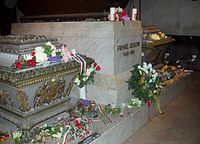Imperial Crypt


Since 1633, the significant members of the Habsburg family have been buried in the so-called Kapuziner or Kaisergruft (Imperial crypt) in Vienna. One hundred forty-six aristocrats, including twelve Emperors, 19 Empresses and around 100 Archdukes have found their resting place here.
The Imperial Burial Vault lies below the Capuchin Church, which was founded in 1617 and built between 1622 and 1632. To this day, the Capuchin friars are the guardians and caretakers of the vault. According to tradition, from 1654 to 1878, the actual hearts of the Habsburgs were removed from their bodies and entombed in a special vault in the Church of the Augustinian Friars. Their intestines were placed in copper urns in the Dukes Crypt of the Vienna cathedral, the Stephansdom.
The Kapuzinergruft today consists of an interconnected series of ten subterranean vaulted rooms, built at various times as more space was needed.
The Founders' Vault
The Gründergruft is the oldest part of the Kaisergruft (1622 - 1632), dating from Empress Anna's foundation of the church, and lays under the Emperor Chapel at the left of the nave of the church above. The room is low, plain, and windowless, and visible through baroque gates from Leopold's Vault. Here stand the two plain sarcophagi of the founding couple.
- Empress Anna (1585 - 1618)
- Emperor Matthias (1557 - 1619).
Leopold's Vault
The Leopoldsgruft was built beginning in 1657 under Leopold I, following the edict of his predecessor Ferdinand III that the hereditary burial place of the imperial family would be in this church.
Children's Columbarium
Turning to the left of the gates to the Founders' Vault, in the 25-foot thick east foundation wall of the church are twelve recessed niches built in the 1960s containing sarcophagi of 12 children. The coffins had previously been in either the Founders' Vault or the main part of this vault, but were generally in poor condition and were placed into identical cases. No markings or documentation identifies which child lies in which coffin, but those buried in these niches are:
Children of Emperor Ferdinand III:
- Maximilian Thomas (1638 - 1639)
- Philipp August (1637 - 1639)
- Theresia Maria (1652 - 1653)
- Ferdinand Josef (1657 - 1658)
Children of Emperor Leopold I:
- Ferdinand Wenzel (1667 - 1668)
- Johann Leopold (1670)
- Maria Anna (1672)
- Anna Maria Sophia (1674)
- Maria Josepha (1675 - 1676)
- Christina (1679)
- Maria Margareta (1690 - 1691)
Grandchild of Emperor Ferdinand III, through his daughter Archduchess Maria Anna Josepha (buried in the Main Hall) who married Johann Wilhelm, Elector Palatine:
- Unnamed (1686)
Main Hall
In front of the Children's Columbarium:
- Queen Maria Anna of Portugal (9 July 1683 - 14 August 1754) (urn containing her heart), daughter of Emperor Leopold I. Body in Lisbon, beside her husband John V of Portugal.
Proceeding along the north wall, east-to-west:
- Archduchess Maria Josepha (1687 - 1703), daughter of Emperor Leopold I.
- Archduchess Maria Anna Josepha (20 December 1654 - 4 April 1689), daughter of Emperor Ferdinand III.
- Queen Eleonora Maria of Poland (21 May 1653 - 17 December 1697), daughter of Emperor Ferdinand III. Wife of Michał Wiśniowiecki, King of Poland, then of Charles IV, Duke of Lorraine by whom she became grandmother of Emperor Franz Stephen (husband of Empress Maria Theresia).
- Empress Eleonora Magdalena of Mantua-Nevers-Gonzaga (18 November 1630 - 6 December 1686), third wife of Emperor Ferdinand III. Founder of the Sternkreuzorden.
- Empress Margarita Teresa (12 August 1651 - 12 March 1673), niece and first wife of Emperor Leopold I at age 15.
- Empress Maria Leopoldina (6 April 1632 - 7 August 1649), second wife of Emperor Ferdinand III. Married at age 16, died in childbirth of Karl Josef (buried in the Bishops Row of the New Vault) the next year.
- Empress Maria Anna, Infanta of Spain (18 August 1606 - 13 May 1646), first wife of Emperor Ferdinand III.
- Archduchess Maria Amalia (5 April 1724 - 19 April 1730), daughter of Emperor Karl VI.
- Empress Claudia Felicitas (30 May 1653 - 8 April 1676), (urn containing her heart) second wife of Emperor Leopold I. Body, by her own request, beside her mother in the Dominican Church in Vienna.
Proceeding along the south wall, east-to-west:
- Archduchess Maria Theresia 1684 - 1696
- Archduke Leopold Joseph 1682 - 1684
- Emperor Ferdinand III (1608-1657)
- Princess Maria Antonia 1669 - 1692
- King Ferdinand IV. von Ungarn und Böhmen 1633 - 1654
- Archduke Leopold Johann 1716 - 1716
- Archduchess Maria Magdalena 1689 - 1743
- Empress Eleonora Magdalena von der Pfalz-Neuburg 1655 - 1720
Karl's Vault
Maria Theresia's Vault
The double casket of Maria Theresia and her husband, Francis I, sculpted by B. F. Moll, is of particular artistic merit and is probably the most glorious in terms of design.
Franz's Vault
Ferdinand's Vault
The Tuscans' Vault
The New Vault
Franz Joseph's Vault
Francis Joseph, in 1916, was the last emperor entombed here.
The Crypt Chapel
The most recent arrival is Zita, Austria's last Empress, who died in 1989 in exile but received a very solemn funeral service when she was entombed.
